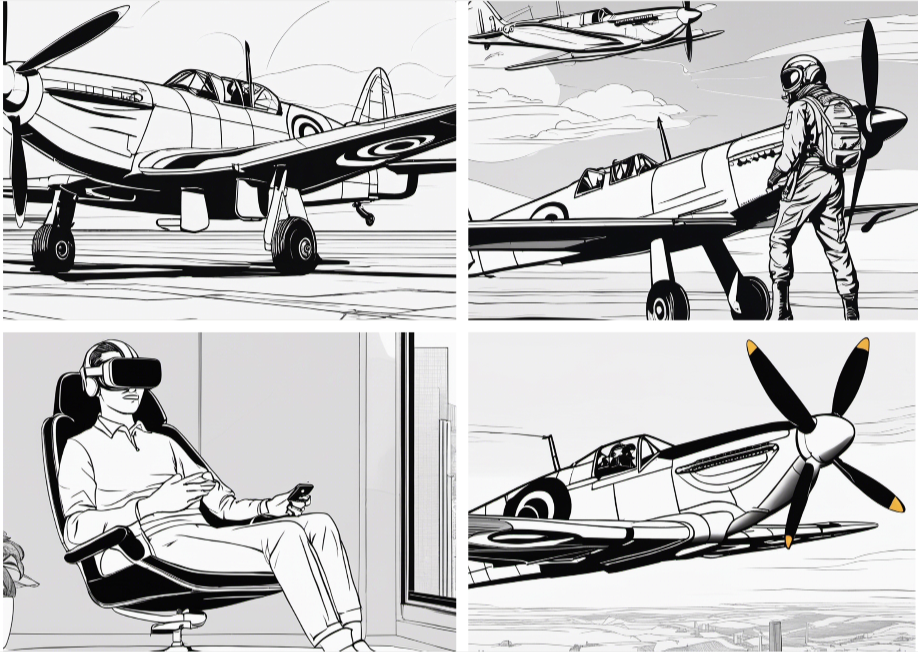KIT208 - Flight Sim
A downloadable game
Introduction
Inspired by the resilience of the military and their aviators, this application was designed to train their abilities further, to sharpen their mind and reaction speed. Although the simulator is still under development, it shows a great potential for what it can do for the future of the Air Force.
Description
The application lets the user operate an airplane from a first-person view, creating an immersive experience of sitting in a Spitfire airplane. The user will feel as if they are holding the control stick, as they are holding the right VR controller, to control if the airplane moves up, down, left, or right. As Chris Dede emphasizes in his article Immersive Interfaces for Engagement and Learning, immersive interfaces can deepen the learners understanding, and improve their engagement in the subject. He states that immersion is based on the user’s belief that it is real, and this will seem so if the interface is based on the design strategies of actional, symbolic, and sensory factors. These factors would be the goal to reach for the simulation, since VR is already a big step in the right direction towards better immersion, as Dede addresses himself.
When it comes to aerial training, it is extremely dangerous to make a mistake, so dangerous that it most likely will cost once life if the one in the cockpit is too inexperienced. Something even more dangerous is aerial combat, which is extremely fatal. Therefore, the application aims to remove this danger completely, by making it a virtual experience, to train the pilots before they try to fly an actual airplane. Furthermore, by minimizing the risk of crashing an airplane, through extensive VR training, more money might be saved on destroyed airplanes, and a lot of fuel can be saved as well.
For the interface to be applicable, it must be a fully functional simulation of flying an airplane. Furthermore, the closer it gets to realistic physics, and the more haptic feedback the user can get, the better the application will serve its function. To further strengthen the point for making this simulation as close to flying a real airplane is possible, is to minimize the chance of cybersickness. Natalie McHugh addresses this big problem there is with VR, in her thesis Measuring and Minimizing Cybersickness in Virtual Reality, she goes into detail about how cybersickness occurs, and how to minimize it when using VR technologies. One factor is that the eyes see movement, and the body doesn’t feel anything. This problem can be combated through better immersion and making it so the player feels like it is more realistic than computer generated.
For this simulation, the chosen engine was Unity, since it provides a lot of support for VR creating. The VR technologies used to test the application throughout the process of creating it was an Oculus headset, since it was the available option and is a high-end VR headset.
Interaction Design
The interaction in the simulation needs to be as close to reality as possible. Therefore, will the right controller act as the control stick. Unfortunately, there wasn’t enough equipment to make it a truly close to reality experience, therefore the throttle up would be placed on the right controller’s trigger, and the throttle down to be placed on the right controller’s grip.

This storyboard was made to illustrate, how if an immersive enough simulation was achieved, it could feel almost as if the user was flying an actual airplane. First the airplane would be selected, then the pilot would go to the cockpit and sit in it, only to be a person in a chair controlling the airplane in a computer program, then the user would fly the airplane, and learn to master it through rigours training.
As it can be seen in the itch.io devlogs, there isn’t much of a finalized project when wearing the VR headset. The airplane can be controlled through the keyboard very well, but only be rotated in VR as it stands now, sadly the thrust of the airplane has not been implemented properly yet.
Technical development
- Game engine used to make the simulation: Unity
- Hardware used for running the simulation: Lenovo laptop, and Oculus VR headset
- Interactions:
- PC: Space for throttle up, Ctrl for throttle down, arrows or WASD for rotational forces.
- VR: Rotate right controller for rotating airplane.
Description of 3D models
The three used 3D models are the imported airplane (Spitfire), self-made runway, and the terrain using Unity’s terrain builder.
The spitfire shows the airplane the user is to fly.
The runway is placed to increase the realistic feel.
The terrain is built for the user to have an actual area to fly in.
References
Cybersickness article:
McHugh Natalie. “Measuring and Minimizing Cybersickness in Virtual Reality.” University of Canterbury, August 19, 2019.
Immersive interfaces article:
Dede, Chris. “Immersive Interfaces for Engagement and Learning.” Science AAAS, January 5, 2009.
3D models:
Spitfire: https://assetstore.unity.com/packages/3d/vehicles/air/super-spitfire-53217
AI made storyboard:
https://boords.com/ai-storyboard-generator
(Only AI tool used in this assignment)
| Status | Released |
| Author | Jakob Thalbitzer Thiberg |
Download
Development log
- Learning From FailuresSep 25, 2023
- VR ControlsSep 25, 2023
- Flight mechanicsSep 25, 2023
- ScenerySep 25, 2023
- Idea GenerationAug 23, 2023

Leave a comment
Log in with itch.io to leave a comment.